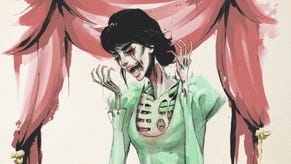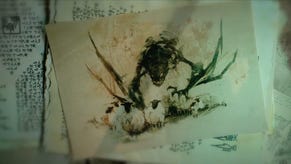Candela Obscura’s first mystery will be solving the horror RPG’s identity crisis
The first new tabletop RPG from Critical Role feels more like Diet Blades with a splash of Vaesen.
Many tabletop RPG players and facilitators make the common mistake of believing that storytelling exists outside of mechanics, that the two facts can be mutually exclusive - e.g. combat eventually ends and gives way to roleplay. It doesn’t help that some of the most popular titles - those often synonymous with the hobby - have done little to disabuse their fans of this notion.
When Darrington Press, the company behind Critical Role and its increasing line of byproducts and spinoffs, announced that monthly actual play Candela Obscura would use a newly designed, bespoke system to power its gothic horror storylines, I wondered if it could be the bridge that allowed the colloquial Critters an avenue into the rich vein of tabletop titles beyond Wizards of the Coast’s shadow.
Judging by Candela Obsura’s quickstart guide, released for free in late May, I’m left feeling ambivalent about that possible future. The RPG’s richly realised world and fascinating take on 1920s post-war anxiety/optimism is undercut by a deep identity crisis around performing as a horror game. Couple that with a worrying hesitancy to let the mechanics uplift any actual storytelling, and this first showing of the Illuminated World’s system feels quite dim.
Lead designers Spenser Starke and Rowan Hall have made no bones about Candela Obscura’s inspirations. Steampunk heist sensation Blades in the Dark is mixed here with Vaesen’s mystery-based approach to encounters, and there’s a bit of Powered by the Apocalypse’s myriad progeny informing character progression. That’s a hell of a pedigree, and even if the digital document doesn’t yet list those games publicly (something Starke addressed on Twitter) it wears them on its structural sleeves.
As a play document, Candela Obscura’s quickstart guide isn’t the best foot forward. Each individual section is well-written but feels separate from each other. Key vocabulary, such as ‘marks’, are referenced well before they’re defined, and all of the guidance for running a session is nested contextually inside the example assignment (Candela Obscura’s term for adventures) - the results will be difficult to parse for newcomers. As a final quibble, I wish all designers would make page number references mandatory, already.
I want to pull out bits of design I like and some I don’t, but that discussion should be framed by a curious omission on Darrington Press’ part - we haven’t seen this Illuminated Worlds system, yet. Tabletop RPGs are translations of standard rules into a specific genre or playstyle, but the designers’ intent with Candela Obscura remains unclear without that original text. It uses a pool of six-sided dice and favours small campaign arcs with narrative-focused sessions. Everything else is divining tea leaves at present.

Candela Obscura's version of crews, called Circles, and how they earn Illumination is a clever, interwoven system and shows off this game at its best. Every character archetype - of which there are five - have distinct roleplay triggers, or Illumination Keys, that fill a pool of experience, eventually filling up and advancing the cohort as a whole. Individuals become stronger, and the Circle unlocks new abilities or resources at the same time. There’s even a ‘retire this campaign’ option, definitively avoiding the power ladder style of gameplay that often poisons dramatic storytelling.
Character creation feels solid but only loosely affiliated with Candela Obscura’s aims as a horror RPG. The fundamentals are killer - I love gilded dice and shifting core ability points when characters earn scars via damage to specific defences (body, brain and the magical-aligned bleed). But every decision lacks the cohesion that originally sold so many folks on Blades in the Dark (and should sell more of you on the criminally overlooked Vaesen). For example, downtime activities have been reduced to healing two core resources and ‘training’, which earns you one additional bonus die. No more opportunities for character interaction when relieving stress or developing connections beyond the camera’s focus.
Speaking of stress, the quickstart includes a smart and sensitive page on alternative portrayals of scars that player characters will inevitably earn via their encounters with the supernatural. Given the horror genre and tabletop gaming’s history of abject ableism especially where mental health is concerned, this is a welcome inclusion. But I can’t help but feel that it goes too far, sanding the edges off of characters by insisting that trauma and scars - whether mental, physical or magical - are better portrayed as change instead of loss. It misses that rejecting the humanity of disabled people is the core concern and instead treats any loss of limb or capacity like a positivity poisoned Instagram reel (‘you have a superpower, not a disability!’).
It feels like an appeal to inoffensiveness in a genre that flirts with our more uncomfortable and messy preoccupations. The sample assignment, Dressed to Kill, readily vilifies the extractive company responsible for its several disasters and casualties, similar to the real-world mining and chemical industries that serve as inspiration (a very cool detail in Candela Obscura’s favour). It pulls its punch when it comes to harming miners driven to rage by some paranormal poisoning, or any of the ideologically opposed factions players might encounter. At every step, the guide maintains that the PCs are good, and their adversaries are evil. How one should develop and deploy such a tidy moral framework isn’t included.
Facilitators unaccustomed to creating spooks at the table might need to crack open a copy of the official Alien RPG or Brindlewood Bay, as the quickstart guide is light on tension-building tips. In fact, the explanation of an assignment’s Climax phase recommends players “think of this as the big ending sequence of an action movie,” a suggestion more anathema to horror than showing the monster in broad daylight.
Candela Obscura wants to be a horror RPG the same way I wanted to be the drummer in a rock band during my freshman year of high school. Enamoured by how cool I would look behind a drum set, I never considered everything else beyond the spotlight. And while that’s not entirely fair to the 26 truncated pages of a book that won’t release until later this year, Darrington Press produces the biggest tabletop media project outside the walls of Wizards of the Coast. The scariest thing here is good design murdered by misguided management.





